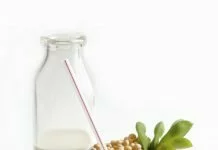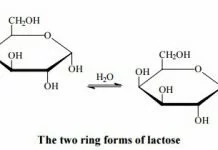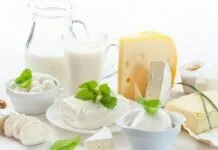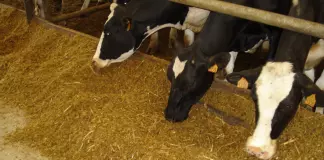Source: fnbnews.com
Milk which is termed as the elixir of life, is the precursor of various relishing indigenous milk products throughout India that contributes maximum to the GDP of India.
With the current trend of value addition in food products, various research works are done to strengthen the business world in terms of sound marketing and customer care output.
Indigenous milk products have grabbed 50% of the market share in dairy sector with rapid urbanisation that quantitatively enhanced modern marketing. The quality of these products has improved substantially with the arrival of FSSAI. In the current scenario, manufacturers and consumers are in a combative mood to give and take the best product without compromising on quality.
Business economics may be a major concern for launching new and innovative indigenous milk products that may regulate the industry. Whatsoever the trend may be, in India with a predominance of vegan population, indigenous milk products are unparalleled to any food commodity even now. The business world must tap this potential treasure to have greater share in national economy.
The major indigenous milk products that rules the north Indian market are khoa, chhana, paneer, ghee and resultant sweets viz. kalakand, rasgulla, sitabhog, srikhand, sandesh and many more mouthwatering relishing sweets that have been recognised as significant contributors of important nutrients to the human diet. In India, there exist huge varieties of indigenous milk products, specific to the different regions, across the country. Most indigenous milk products are produced and sold loose by local halwais/ mithaiwalas (David, 2013). Several government and private organisations have been conducting research on the mechanised and hygienic production as well as distribution of the indigenous milk products. With the current upward trend in national and international health awareness among the consumers, the demand for functional, herbal, low fat food has increased. This has forced the food industry for launching indigenous dairy products in the market with acceptable sensory characteristics.
Overview – Major Indigenous Milk Products of North India
Paneer
Paneer is a popular indigenous variety of soft cheese (David, 2013). Paneer is obtained by acid and heat coagulation of milk. Good quality paneer is characterised by a white colour, sweetish mildly acidic and nutty flavour, spongy body and a close knit structure. Paneer is highly nutritious since it retains about 90% fat and protein, 50% minerals and 10% lactose of the original milk. Paneer is nutritious and wholesome food. It provides one of the methods of conserving, preserving and prolonging shelf life of milk solids in highly concentrated form.
Functional Coconut Paneer
Coconut is an indispensible ingredient in many of the traditional cuisines of Southeast Asian countries including India. Coconut milk and fat is popular for its characteristic nutty flavour and nutritional content. Coconut milk is extracted from freshly grated coconut meat. Fat in coconut is similar to fat in mother’s milk and have similar nutritional effects. Coconut fat helps to maintain a healthy ratio of Omega-6 (w-6) and Omega-3 (w-3) fatty acids, when consumed as a part of a diet. The coconut paneer with 90:10 ratios of buffalo milk and coconut milk was found to be the best among others.
Peanut Paneer Prepared from the Admixture of Peanut (Arachis hypogaea L.) Milk and Skimmed Milk
Peanut and Peanut milk products have nutritional benefits because of their extreme richness in protein, minerals and essential fatty acids such as linoleic and oleic acids, which are considered to be highly valuable in human nutrition. Being free in cholesterol and lactose, peanut milk is also a suitable food for lactose-intolerant consumers, vegetarians and milk allergy patients. Peanut milk may be produced by soaking and grinding full fat raw peanuts with water to get a slurry, subject to filtration. Many ways of producing peanut milk have been done by various researchers (Benchat and Nail, 2006). Peanut paneer prepared from the admixture of peanut milk and skimmed milk 60:40 ratio is best.
Kalakand
Among the indigenous milk products, Kalakand occupies an important place and found to be attractive product amongst all the classes of consumers. Kalakand is partially desiccated milk product with caramelised flavour and granular texture prepared from acidified milk (David, 2013). The granular mass is fused and held together in loosely compact body. The colour of Kalakand varies from off-white to light caramel colour. Being a whole milk concentrate, Kalakand is a good source of protein, mineral, energy giving fat and lactose. It is 4-6 times more nutritious in terms of per unit weight and calorific value. It can be made by two methods, i.e. from milk or from khoa. Kalakand made from milk slightly differs in respect of its manufacturing process to that of kalakand made from khoa.
Herbal Kalakand using Ashwagandha (Withania somnifera)
Ashwagandha (Withania somnifera) is rare and endangered plant and is widely used in Ayurvedic medicine and it is one of the ingredients in many formulations to increase energy, improve overall health and longevity and prevent disease. Supplementation of Ashwagandha with milk is recommended in treatment of stress-oriented hypertension (Kushwaha et al., 2012). Ashwagandha possesses immune modulatory anti-inflammatory, anti-tumour, antioxidant, anticancer properties and having many pharmacologically and medicinally important chemicals, that protect the cells from oxidative damage and disease (Sharma et al., 2011). They are effective in prevention and treatment of different kinds of cancer like colon cancer, lung cancer, blood cancer, breast cancer, prostate cancer, skin cancer, renal cancer, fibrosarcoma and pancreatic cancer (Singh et al., 2011). Herbal kalakand using 1% Ashwagandha is found to be the best.
Functional Kalakand Fortified with Ash Gourd Pulp
Sensory qualities of Kalakand can be altered by addition of Ash gourd pulp. Ash gourd is loaded with nutrients. It is excellent source of vitamin B1 (Thiamine), good source of vitamin C. It is also rich in many minerals like calcium. Ash gourd is used to treat summer fevers, obesity, because it is low in calories and it prevents conversion of sugar into fats. It also helps in boosting memory and other elements. In Ayurveda, the fruit is used to treat epilepsy, lung diseases, asthma, coughs, urine retention and internal hemorrhage. According to the analysis, Kalakand with 15% Ash gourd pulp is found to be the best for preparation of kalakand.
Low Fat Dietetic Kalakand (Maltodextrin as Fat Replacer)
Maltodextrin is easily digestible carbohydrate made from natural corn starch. The starch is cooked and then acid or enzymes are used to break the starch into smaller polymers. Maltodextrin is defined as a product having dextrose equivalent (DE) less than 20. It is recognised as safe food ingredient. Maltodextrin is excellent solids builder for standard and low fat products. Maltodextrin can be used as a fat replacer (Dorp, 1995), texture modifier and bulking agent in dairy products. It provides only 4 calories/g of food. Kalakand prepared from skim milk and 3% maltodextrin was found to be the best in chemical and organoleptic parameters.
Milk cake
Milk cake is a delicious, mouthwatering dessert .This is a unique cake made with just a few ingredients. (Anonymous, 2011).The milk cake is a very popular sweet in northern and central parts of India. It is prepared traditionally by untrained manufacturer (Karwasara et al., 2001).
Milk cake from admixture of buffalo milk and Chickpea (Cicer aritienum Linnaeus) solids.
Bengal Gram or Chickpea (Cicer aritienum. Linnaeus) is very rich in nutrients, especially in protein content (21%). It has therapeutic value and held high by Ayurvedic sciences. According to the analysis, milk cake with 8% was found to be the best among the three chick pea solids milk cake. Milk cake is a common sweetmeat which can be enriched by addition of chickpea solids.
Shrikhand
Shrikhand is one of the important fermented milk products which derives its name from the Sanskrit word Shikharani meaning a curd prepared with added sugar, flavouring agents (saffron), fruits and nuts. It is popular in western parts, especially in Maharashtra, Gujarat and Karnataka. Shrikhand is known for its high nutritive, characteristic flavour, taste, palatable nature and possible therapeutic value. It is very refreshing particularly during summer months. It can be recommended as health food for specific patients suffering from obesity and cardiovascular disease due to its low fat and sugar contents (Swapna and Chavannavar, 2013). Shrikhand is a semi-soft, sweetish-sour, whole milk product prepared from lactic fermented curd (David, 2013). The curd (dahi) is partially strained through a muslin cloth to remove the whey and thus produce a solid mass called chakka, the basic ingredient for Shrikhand (Singh et. al., 2014).
Herbal Shrikhand prepared with Basil (Ocimum basilicum) Extract
Ocimum basilicum L. (Lamiaceae), respectively, named Basil, is an aromatic herb that has been used traditionally as a medicinal herb in the treatment of headaches, coughs, diarrhoea, constipation, warts, worms and kidney malfunctions (Mahajan et al., 2013). The extracts obtained from the plant are extensively brought to use for curing various diseases such as the common cold, inflammation, malaria, heart disease, headaches, stomach disorders, kidney stones, heart disorders, and many more. Herbal shrikhand prepared by incorporating 3% basil extract is found to be the best in organoleptic properties.
Lassi
Lassi is a ready-to-serve popular and traditional fermented milk beverage of the Indian subcontinent. Good quality Lassi should have creamy consistency, smooth texture, glossy sheen and white colour with yellowish tinge. Milk acidic flavour and sweetish taste of Lassi make it a refreshing soft drink. It is flavoured either with salt or sugar and other condiments or spices like ginger, coriander and mint depending on regional preferences. (Aneja et.al., 2002).
Lassi prepared from skimmed milk blended with coconut milk
Coconut milk and fat is an excellent source for preparation of filled milk, infant formulae and margarine. It is popular for its characteristic nutty flavour and nutritional content. Lassi can have good potential market in India, by making the product more palatable, by reducing the production cost and by encouraging people to make lassi adjunct. Skimmed milk and coconut milk can be satisfactorily blended to prepare lassi – 60:40 ratio was found to be the best.
Sandesh
Sandesh is a popular chhana based sweet. Sandesh (meaning “message”) is perhaps the oldest sweetmeat of Bengal where there is a traditional custom to send some Sandesh along with a good message to relative and friends (David, 2013). Steam Sandesh (vapa) is one of the traditional milk products which are still very popular in Bengal. Generally the product is made from cow milk. The sweet is known for its palatability and aroma. It is a good source of milk protein and fat.
Colostrum Steam Sandesh
Colostrums are breast milk produced after the birth of the new born and last for 2-4 days (Kaushik et al., 2002). Colostrums are very important part of breast milk and lays down the immune system and confers the growth factors and other protective factors for the young ones in mammals. This is the source of passive immunity achieved by the mother and is transferred to the baby (Thapa, 2005). Bovine colostrums have been used in many disorders in human beings. Five different types of immunoglulins viz. Ig A, Ig D, Ig E, Ig G and Ig M have been isolated from colostrum. Bovine colostrum contains 8-25%, Ig G whereas human colostrum contain2% IgG. These are protein molecules, which have important role in the body to fight against infection (Davidson et al.,1989).There is a need for utilisation of colostrum to prepare Steam Sandesh as it will enhance the therapeutic value of the product which otherwise go as waste. Steam Sandesh having 50:50 ratio of colostrum and cow-milk was most acceptable.
Sita Bhog
Sita Bhog is a very popular sweet of West Bengal, especially in Burdwan district. It is dazzling white in colour with moist shining surface. It has a pleasant flavour, soft body and a small noodle like structure. It is prepared from chhana and good quality rice dust in 4:1 ratio (Ghosh ,2009). Special variety of Govind bhog rice gives best flavour and taste to Sita Bhog. Then the mixture of chhana and rice dust was put into the ‘sev’ mould for the preparation of noodles. These noodles are fried in ghee and then soaked into sugar syrup for 2-3 hrs. Then the sugar was drained and Sita Bhog was ready to serve.
Colostrum Sita Bhog
There is a need for utilisation of colostrum as it will enhance the therapeutic value of the product which otherwise go as waste, colostrum may be added with cow milk to get a better Sita Bhog. Sita Bhog having 50:50 ratio of colostrum and cow-milk was most acceptable.
Rasgulla
Rasgulla is regarded as the king of Indian milk sweets. It is prepared by kneaded chhana balls under controlled cooking in boiling sugar syrup. Rasgulla is a juicy and spongy sweet meat and prepared from cow and buffalo milk chhana, but good Rasgulla is prepared from cow milk chhana. In appearance, it is snow white, soft and succulent sphere shaped (David, 2013; Tarafder and Prasad 1987).
Whey protein concentrates for Rasgulla manufacture
Whey protein is one of the major proteins found in cow’s milk comprising 20% of total milk protein. Whey protein referred to as a group of individual proteins contains water, lactose, protein, minerals (Calcium, Phosphorous, and Magnesium) and fat. The best known effect of whey protein is its ability to increase lean muscle mass and boost the immune system. Whey protein contains minerals for bone strength, plus essential, semi-essential and non-essential amino acid for tissue formation. Thus Rasgulla was manufactured, 0.5% WPC proved to be the best.
Conclusion
Since time immortal indigenous milk products occupied the heart of Indian masses from grass root level up to top layer of society. Modern advances made these products rather attractive and competitive in the business world. Technical knowhow made quality of the products rather comprehensive to national and international scenario as well. Thus qualities of indigenous milk products are embedded now with utmost care to catch business trend of the market for greater revenue and consumer satisfaction.
(The writer is professor, department of dairy Technology, Sam Higginbottom Institute of Agriculture Technology and Sciences, Allahabad. He can be contacted at [email protected])





































